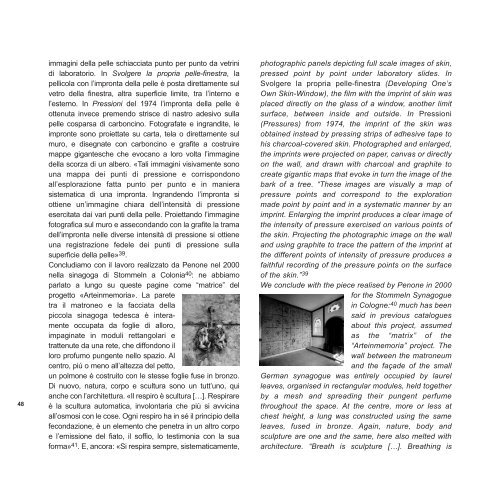Adachiara Zevi - arteinmemoria
Adachiara Zevi - arteinmemoria
Adachiara Zevi - arteinmemoria
You also want an ePaper? Increase the reach of your titles
YUMPU automatically turns print PDFs into web optimized ePapers that Google loves.
48<br />
immagini della pelle schiacciata punto per punto da vetrini<br />
di laboratorio. In Svolgere la propria pelle-finestra, la<br />
pellicola con l’impronta della pelle è posta direttamente sul<br />
vetro della finestra, altra superficie limite, tra l’interno e<br />
l’esterno. In Pressioni del 1974 l’impronta della pelle è<br />
ottenuta invece premendo strisce di nastro adesivo sulla<br />
pelle cosparsa di carboncino. Fotografate e ingrandite, le<br />
impronte sono proiettate su carta, tela o direttamente sul<br />
muro, e disegnate con carboncino e grafite a costruire<br />
mappe gigantesche che evocano a loro volta l’immagine<br />
della scorza di un albero. «Tali immagini visivamente sono<br />
una mappa dei punti di pressione e corrispondono<br />
all’esplorazione fatta punto per punto e in maniera<br />
sistematica di una impronta. Ingrandendo l’impronta si<br />
ottiene un’immagine chiara dell’intensità di pressione<br />
esercitata dai vari punti della pelle. Proiettando l’immagine<br />
fotografica sul muro e assecondando con la grafite la trama<br />
dell’impronta nelle diverse intensità di pressione si ottiene<br />
una registrazione fedele dei punti di pressione sulla<br />
superficie della pelle» 39 .<br />
Concludiamo con il lavoro realizzato da Penone nel 2000<br />
nella sinagoga di Stommeln a Colonia 40 : ne abbiamo<br />
parlato a lungo su queste pagine come “matrice” del<br />
progetto «Arteinmemoria». La parete<br />
tra il matroneo e la facciata della<br />
piccola sinagoga tedesca è interamente<br />
occupata da foglie di alloro,<br />
impaginate in moduli rettangolari e<br />
trattenute da una rete, che diffondono il<br />
loro profumo pungente nello spazio. Al<br />
centro, piú o meno all’altezza del petto,<br />
un polmone è costruito con le stesse foglie fuse in bronzo.<br />
Di nuovo, natura, corpo e scultura sono un tutt’uno, qui<br />
anche con l’architettura. «Il respiro è scultura […]. Respirare<br />
è la scultura automatica, involontaria che più si avvicina<br />
all’osmosi con le cose. Ogni respiro ha in sé il principio della<br />
fecondazione, è un elemento che penetra in un altro corpo<br />
e l’emissione del fiato, il soffio, lo testimonia con la sua<br />
forma» 41 . E, ancora: «Si respira sempre, sistematicamente,<br />
photographic panels depicting full scale images of skin,<br />
pressed point by point under laboratory slides. In<br />
Svolgere la propria pelle-finestra (Developing One’s<br />
Own Skin-Window), the film with the imprint of skin was<br />
placed directly on the glass of a window, another limit<br />
surface, between inside and outside. In Pressioni<br />
(Pressures) from 1974, the imprint of the skin was<br />
obtained instead by pressing strips of adhesive tape to<br />
his charcoal-covered skin. Photographed and enlarged,<br />
the imprints were projected on paper, canvas or directly<br />
on the wall, and drawn with charcoal and graphite to<br />
create gigantic maps that evoke in turn the image of the<br />
bark of a tree. “These images are visually a map of<br />
pressure points and correspond to the exploration<br />
made point by point and in a systematic manner by an<br />
imprint. Enlarging the imprint produces a clear image of<br />
the intensity of pressure exercised on various points of<br />
the skin. Projecting the photographic image on the wall<br />
and using graphite to trace the pattern of the imprint at<br />
the different points of intensity of pressure produces a<br />
faithful recording of the pressure points on the surface<br />
of the skin.” 39<br />
We conclude with the piece realised by Penone in 2000<br />
for the Stommeln Synagogue<br />
in Cologne: 40 much has been<br />
said in previous catalogues<br />
about this project, assumed<br />
as the “matrix” of the<br />
“Arteinmemoria” project. The<br />
wall between the matroneum<br />
and the façade of the small<br />
German synagogue was entirely occupied by laurel<br />
leaves, organised in rectangular modules, held together<br />
by a mesh and spreading their pungent perfume<br />
throughout the space. At the centre, more or less at<br />
chest height, a lung was constructed using the same<br />
leaves, fused in bronze. Again, nature, body and<br />
sculpture are one and the same, here also melted with<br />
architecture. “Breath is sculpture […]. Breathing is


